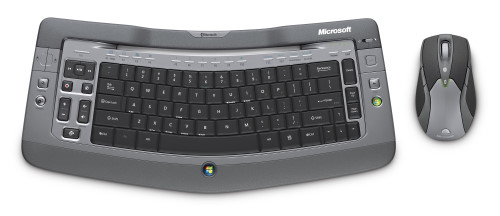

To use an F-key function, you must first press the F-Lock key. There’s also a row of F-keys, but like the Apple aluminum keyboard, their use as F-keys is secondary. Like the other one-touch buttons, these buttons can be reassigned using Microsoft’s software. Other one-touch buttons include My Documents, My Photos, Calculator, and Gadgets (which is assigned to Dashboard by default). If you’re used to using Apple’s aluminum keyboard, the 7000’s multimedia keys are a welcome feature. The 7000 keyboard also has dedicated multimedia keys, which include volume, mute, play/pause, rewind, fast-forward, and a Music button assigned to iTunes by default. You can easily customize the keyboard’s programmable keys via the IntelliPoint software. I received a second 7000 keyboard, and the My Favorites keys were much more responsive, requiring only a single tap to active a button’s action. I didn’t find them sensitive to my touch, and I often had to push a Favorite key two or three times to activate the assigned action. With my first test unit of the 7000 keyboard, I had problems with these keys. The keyboard’s top row also has three touch-sensitive, programmable floating My Favorites keys. I easily assigned each button to a program for example, I assigned the Back button to Twitterrific ( ), and the Live Call button to Adium. All four buttons can be reassigned using Microsoft’s IntelliType Pro software, which appears as a pane in System Preferences. The upper left has a Back button and Home button that by default are designed for your Web browser, a Mail button for launching an e-mail program, and a Live Call button that defaults to opening Windows Messenger (it can also be programmed to open iChat). Several helpful one-touch buttons rest atop the 7000 keyboard. I prefer the feel of the 7000 keyboard over that of Apple’s aluminum keyboard because it feels more sturdy. The keys are easy to press and responsive enough to not disturb the flow of my typing.


I don’t find the curve any more comfortable than a straight keyboard layout, but I’ve been fortunate enough to not have any physical problems when using different keyboard shapes. But adapting to the curve didn’t hinder my typing speed. I’m a self-taught typist (read: I don’t type the proper, traditional way), and I had to adjust to the curve by turning my hands in a slightly different angle than how I usually hold them over a straight keyboard. The keyboard is an elegant black with a smoke-colored plastic frame and a slight curve to make it more ergonomically correct.


 0 kommentar(er)
0 kommentar(er)
